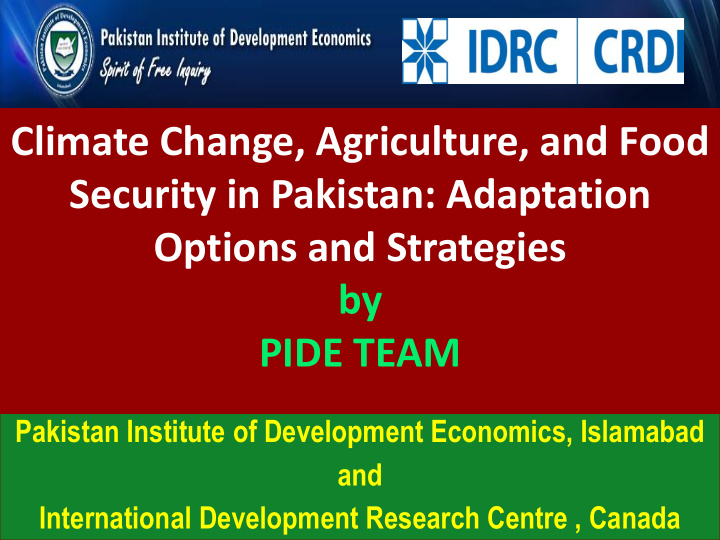



Climate Change, Agriculture, and Food Security in Pakistan: Adaptation Options and Strategies by PIDE TEAM Pakistan Institute of Development Economics, Islamabad and International Development Research Centre , Canada
Introduction • Scientific community agrees that climate change is already a reality. • 262 mln people were affected by climate disasters in 2004 • Over 98% in developing countries
Introduction………. • Pakistan is the most vulnerable countries in South Asia. In 2010 floods, 20 million people were seriously affected – women, elderly, children, poor
Potential impacts of climate change on agricultural crops POSITIVE IMPACTS PROJECTED CHANGES NEGETIVE IMPACTS Higher insect infestations Higher productivity • temperatures • Drier or wetter conditions Crop damages from New crops extreme heat • frequency climatic events Lower moisture stress Planning problems • Enhanced atmospheric CO2 less reliable forecasts Higher productivity from • Changing market conditions enhanced CO2 Moisture stress & droughts Accelerated Lower herbicide & maturation rates pesticide efficacy Longer growing seasons Higher weed growth and disease outbreaks Greater Soil Erosion Uncertain & depends on the Net impact adaptation measures. Source: Lemmen and Warren (2004 )Climate Change Impacts and Adaptation: A Canadian Perspective.
• Climatic factors are direct inputs to agriculture. • Cereals are already under heat stress in South Asia. Yields Humidity Factors Influencing Crop Production could by 30% by end of century due to CC (IPCC, 2007). Solar Radiation • Pakistan is among the most vulnerable countries in South Asia Rainfall -- ranked 12 th most vulnerable climate change in world. Temperature • 1 0 C wheat yield by 5 – 7% in Pakistan (Sivakumar et al , Wind speed Transpiration 2011 Evaporation Source: Ramamasy and Bass (2007) Climate Variability and Change: Adaptation to Drought in Bangladesh . Asian Disaster Preparedness Centre and FAO.
• These changes & their effects influence socio-economic and environmental conditions -- impacting livelihoods, health, settlements. • Majority of our population depends on agriculture. • 80% irrigated making agriculture most sensitive to CC
Sector contributions and sensitivities to climate change http://www.regional.org.au/au/asa/2010/climate-change/ adaptation/7418_hayman.htm
Water availability for food self-sufficiency (by 2050) Pakistan is ranked 28 th – affected by CC, 22 in Africa ( IUCN, 2009) . “approaching end of the road unless income growth … allows .. to import the food required” (P65). <1,300 m3/capita/year – deficit. Falkenmark, et al (2009)
Floods and Droughts Co-exist Fire Drought
Extreme weather events serious disrupt food security Imagine the human misery
Women and Children health at risk
Imbalance Leads to Chronic food & Nutritional Insecurity
Special focuses of the project are to: review & evaluate existing policies & support functions of various institutions examine the impact of CC on agricultural productivity and food security; investigate the factors affecting the farmers’ decisions related to adaptations; identify indigenously developed best-practices and adopted by the communities and assess their potential to be scaled;
Coping Strategies International experience. Pakistan? IRRI developed drought resistant rice Floating mat garden
Build analytical capacity of the staff and students Exploring the gender role in farm and off-farm activities with reference to adaptations towards adverse climate events.
No amount of technologies or external assistance can feed a nation that does not itself prioritize food security and agriculture (Norman Borlaug), which is highly dependent climate
Gaps in Research • CC research on Pakistan lacks human dimension: How people – the poor, the vulnerable, children, females are affected by the CC. This understanding is vital to come up with credible strategies and actions. • There is paucity of micro evidence on impact of CC and adaptation on crop yields.
The approach? • Comprehensive review of policy & research documents and development initiatives dealing with CC, food security and disaster management issues; • Review of R&D activities to assess how far the research activities are geared to meet the challenges of CC; • District level panel data shall be analysed – to capture inter-temporal and inter-spatial variations • Experimental data from various research stations of NARS be examined -- sharply focused research and more precisely controlled factors and can be related to changes in technology and climatic variables
• Rapid Appraisal and focus group discussions: community perceptions on CC and coping strategies; Identification of areas for in depth case studies. • Household survey data -- captures spatial variation as well as farm level technology, farm/farmer specific characteristics and other socio-economic factors to estimate effect of CC & other stressors on productivity & cropping pattern in different agro- ecologies. • The potential of indigenously developed best-practices & adopted shall be assessed for scaling up with special emphasis on water and land conservation practices
Project Outcomes • Policy & research gaps identified -- CC issues reprioritized for policy decisions; • Institutional capacity enhanced through training and other relevant activities; • Comprehensive knowledge on adverse climate events happened overtime documented for different agro- ecologies; • Experimental data interpreted in relation to CC variables; • Emerging challenges for R&D specified from CC perspective
Project Outcomes….. • Impacts of adoption technological packages analysed at household and regional levels • Critical factors influencing adoption identified • Preparation of HH and area specific action plans to combat CC effects • Feasibilities of best practices developed for replication under relevant situations
Recommend
More recommend